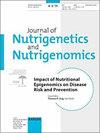The FTO Gene, Browning of Adipose Tissue and Omega-3 Fatty Acids.
Q Agricultural and Biological Sciences
Journal of Nutrigenetics and Nutrigenomics
Pub Date : 2016-01-01
Epub Date: 2016-08-20
DOI:10.1159/000448617
引用次数: 6
Abstract
Body mass index (BMI) is a complex trait with high heritability. In population studies, it is considered a surrogate for obesity [1] . In large genome-wide association studies, the strongest genetic signal for BMI has been the fat mass and obesity-associated (FTO) locus [2] . Eighty-nine genetic variants within introns 1 and 2 of the FTO have been associated with BMI. Browning of adipose tissue has physiological relevance, and disorders of mitochondrial function and brown fat may play a role in pathophysiological aspects of obesity [3] . Browning adipocytes are a key site of energy expenditure; therefore, shifting adipocyte differentiation towards a brown adipocyte-like phenotype may increase energetic efficiency in mammals. Mammals have two types of adipose tissue: white adipose tissue (WAT), which is the most abundant, stores extra calories, and brown adipose tissue, which dissipates energy through mitochondrial uncoupling and the production of heat. Recently, a number of investigators have shown that there is a third type of fat cell, the ‘beige’ adipocyte. This beige cell transitions between states of energy storage and dissipation. It can be induced and is found in adult humans [4] . The potential importance of the fatty acid composition of dietary fats as a factor that plays a role in adipose tissue development and function has been actively investigated. Over the years, Ailhaud et al. [5] , Massiera et al. [6] and Pisani et al. [8] have contributed enormously to understanding the role of arachidonic acid (AA) and its metabolites derived from the cyclooxygenase pathway in increasing WAT proliferation and decreasing browning of WAT. Under isoenergetic isolipidic conditions, inclusion of AA in the diet impaired brite adipocyte recruitment in the subcutaneous WAT compared to mice fed a standard diet [7] . The data of Massiera et al. [6] regarding the fat mass show that perinatal exposure of mice to a high omega-6 [linoleic acid (LA)] fatty acid diet, as it is today in Western diets, results in a progressive accumulation of body fat across generations. This is consistent with the data showing that in humans, overweight and obesity have steadily increased over the last 30–40 years, in addition to occurring earlier in life. Today, there is more obesity in children worldwide than ever before. The inhibitory role of the omega-6 fatty acids (LA + AA) in the browning process of white fat cells has been precisely investigated. Prostaglandin E 2 (PGE2), a metabPublished online: August 20, 2016FTO基因,脂肪组织褐变和Omega-3脂肪酸。
本文章由计算机程序翻译,如有差异,请以英文原文为准。
求助全文
约1分钟内获得全文
求助全文
来源期刊

Journal of Nutrigenetics and Nutrigenomics
GENETICS & HEREDITY-NUTRITION & DIETETICS
CiteScore
1.86
自引率
0.00%
发文量
0
审稿时长
>12 weeks
期刊介绍:
The emerging field of nutrigenetics and nutrigenomics is rapidly gaining importance, and this new international journal has been established to meet the needs of the investigators for a high-quality platform for their research. Endorsed by the recently founded "International Society of Nutrigenetics/Nutrigenomics", the ‘Journal of Nutrigenetics and Nutrigenomics’ welcomes contributions not only investigating the role of genetic variation in response to diet and that of nutrients in the regulation of gene expression, but is also open for articles covering all aspects of gene-environment interactions in the determination of health and disease.
 求助内容:
求助内容: 应助结果提醒方式:
应助结果提醒方式:


